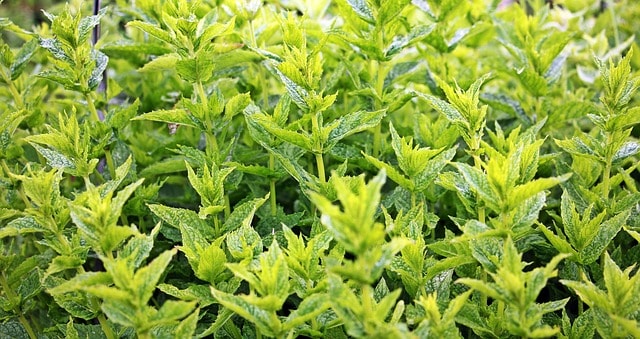Mint is a popular herb that is easy to grow and can be used in a variety of dishes and drinks. However, even the most experienced gardeners can struggle with keeping their mint plants healthy.
If you notice that your mint plant is starting to wilt or turn yellow, it may be dying. But don’t worry, there are several steps you can take to save a dying mint plant and get it back to its healthy, vibrant state.
To revive a dying mint plant, it is important to first understand its needs. Mint plants require proper watering, soil and drainage, and nutrient requirements, among other things.
Identifying signs of a dying mint plant is also crucial in determining the cause of the problem and taking the appropriate steps to fix it. Common diseases and pests affecting mint plants can also contribute to the plant’s decline, so it’s important to be aware of these issues and take preventative measures to avoid them.
Reviving a dying mint plant may seem like a daunting task, but with the right knowledge and care, it is possible to bring it back to life. Whether your plant is suffering from root rot, lack of nutrients, or other issues, there are several steps you can take to save it.
By following proper watering techniques, ensuring proper soil and drainage, and providing the right nutrients, your mint plant can thrive once again.
Key Takeaways
- Understanding the needs of mint plants is crucial for their survival.
- Identifying signs of a dying mint plant can help determine the cause of the problem.
- Proper watering, soil and drainage, and nutrient requirements are essential for reviving a dying mint plant.
Other popular posts you shouldn’t miss on:
Understanding Mint Plant Needs
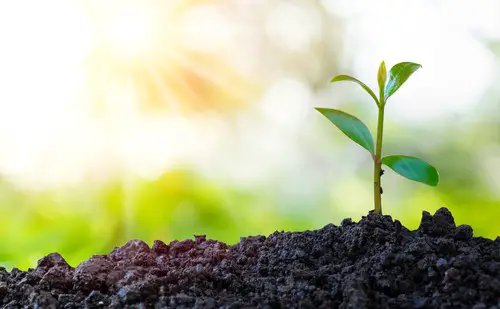
Mint plants are relatively easy to grow, but they do have specific needs that must be met for them to thrive. Here are some key factors to keep in mind when caring for your mint plant:
1. Watering
Mint plants require consistent moisture to thrive. They prefer soil that is consistently moist but not waterlogged. Overwatering can lead to root rot, which can quickly kill the plant. Underwatering can cause the leaves to wilt and dry out. It is important to strike a balance between too much and too little water.
2. Sunlight
Mint plants prefer partial shade, but they can also tolerate full sun. However, if they are grown in full sun, they will require more water to stay hydrated. In hotter climates, it is best to provide some shade during the hottest parts of the day.
3. Climate and Temperature
Mint plants prefer a mild climate with temperatures between 60-70°F (15-21°C). They can tolerate slightly cooler temperatures, but they are not frost-resistant. If the temperature drops below freezing, the plant will likely die. In warmer climates, it is important to keep the plant well-watered to prevent it from drying out.
4. Humidity
Mint plants prefer a humid environment, but they can tolerate lower humidity levels. In dry climates, it may be necessary to mist the plant occasionally to help it retain moisture.
5. Lighting Conditions
Mint plants require at least 6 hours of sunlight per day. If they are grown indoors, it is important to place them near a window that receives plenty of sunlight. If they are grown outdoors, it is important to choose a location that receives adequate sunlight throughout the day.
By understanding the specific needs of your mint plant, you can provide it with the care it needs to thrive. Keep these factors in mind when watering, positioning, and caring for your plant, and you will be rewarded with a healthy, vibrant mint plant.
Identifying Signs of a Dying Mint Plant
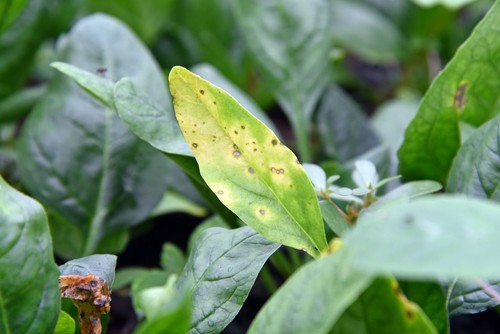
Mint plants are generally easy to care for and maintain. However, they can become sickly and start to die if they are not given proper attention. It is important to recognize the signs of a dying mint plant so that you can take action to save it. Here are some of the common signs to look out for:
1. Wilting Leaves
One of the first signs that your mint plant is dying is wilting leaves. If the leaves look droopy and wilted, it means that the plant is not getting enough water. Mint plants need moist soil to thrive, and if the soil is too dry, the leaves will start to wilt and eventually die.
2. Brown, Crunchy Leaves
If you notice that the leaves of your mint plant are turning brown and crunchy, it could be a sign of several problems. One of the most common reasons for this is overwatering. Mint plants can be susceptible to root rot if they are overwatered, which can cause the leaves to turn brown and crunchy.
3. Weak Stems
Another sign of a dying mint plant is weak stems. If the stems of the plant are weak and unable to support the weight of the leaves, it means that the plant is not getting enough nutrients. This can be caused by poor soil quality or lack of fertilizer.
4. Soft, Sickly Leaves
If the leaves of your mint plant are soft and sickly, it could be a sign of a fungal disease. Fungal diseases can be caused by overwatering, poor soil quality, or lack of air circulation. If you notice soft, sickly leaves, it is important to take action to prevent the spread of the disease.
5. Dropped Leaves
When a mint plant is dying, it will often drop leaves as a way to conserve energy. If you notice that your plant is losing leaves, it could be a sign that it is struggling to survive. It is important to take action to address the underlying problems that are causing the plant to die.
6. Dry Leaves
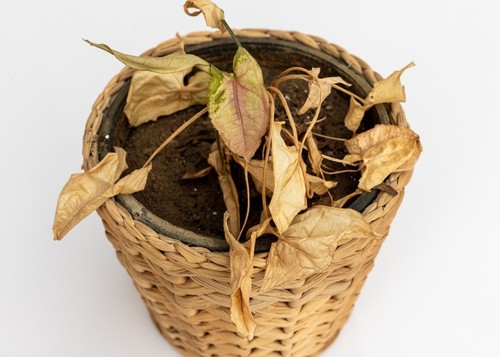
If the leaves of your mint plant are dry and brittle, it could be a sign that the plant is not getting enough water. Mint plants need moist soil to thrive, and if the soil is too dry, the leaves will start to dry out and eventually die.
7. Wilting
If your mint plant is wilting, it is a sign that it is not getting enough water. This can be caused by under watering or soil that is not retaining enough moisture. It is important to water your mint plant regularly to prevent wilting.
8. Drought
Mint plants are sensitive to drought and can wilt quickly if they are not given enough water. If your area is experiencing a drought, it is important to water your mint plant regularly to prevent it from dying.
Common Diseases and Pests Affecting Mint Plants
Mint plants are susceptible to various diseases and pests that can cause them to wilt and die if left untreated. Here are some of the most common diseases and pests that affect mint plants:
1. Fungal Diseases
Fungal diseases can cause mint plants to develop yellow or brown spots on their leaves, which can eventually lead to the plant’s death. Common fungal diseases that affect mint plants include anthracnose, rust, and mint blight.
To treat fungal diseases, it is recommended to remove the infected leaves and spray the plant with a fungicide.
2. Pest Infestations
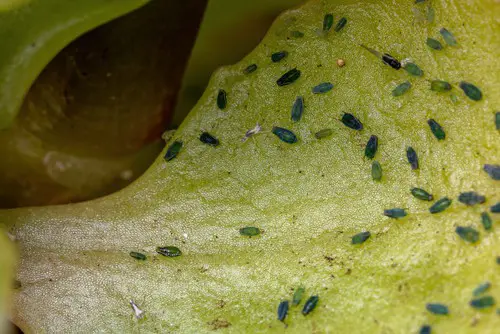
Mint plants are also prone to pest infestations, which can cause them to wilt and die. Common pests that affect mint plants include aphids, spider mites, mealybugs, cutworms, and thrips. To treat pest infestations, it is recommended to remove the infected leaves and spray the plant with an insecticide.
3. Stolon Rot
Stolon rot is a fungal disease that affects the roots of mint plants, causing them to become soft and mushy. This disease can be caused by overwatering or poor drainage. To prevent stolon rot, it is recommended to ensure that the soil is well-draining and not water the plant excessively.
4. Caterpillars
Caterpillars can also be a problem for mint plants, as they can eat the leaves and cause the plant to wilt. To prevent caterpillar infestations, it is recommended to remove any caterpillars that are found on the plant and spray the plant with an insecticide.
5. Decay
Decay can be caused by overwatering or poor drainage, which can cause the roots of the plant to rot. To prevent decay, it is recommended to ensure that the soil is well-draining and not water the plant excessively.
Proper Watering Techniques for Mint Plants
Mint plants require consistent and proper watering to thrive. Overwatering and underwatering are the most common reasons for a dying mint plant. When it comes to watering, it is important to find a balance between not enough and too much water.
1. Overwatering
Overwatering can lead to root rot, which can be fatal for a mint plant. Signs of overwatering include yellowing leaves, a mushy stem, and a foul odor coming from the soil. If a mint plant is overwatered, it is important to stop watering immediately and allow the soil to dry out before resuming watering.
2. Underwatering
Underwatering can cause a mint plant to wilt and dry out. Mint plants prefer moist soil, and if the soil dries out, the plant can quickly become stressed and die. Signs of underwatering include wilted leaves, dry soil, and a droopy appearance. To avoid underwatering, it is important to water the plant consistently and check the soil regularly.
3. Watering from Below
Watering from below is a technique that can help prevent overwatering and underwatering. To water from below, place the mint plant in a container filled with water and allow the soil to absorb the water from the bottom up. This technique ensures that the soil is evenly moist and helps prevent water from sitting on top of the soil.
4. Rainwater

Rainwater is an excellent source of water for mint plants. It is free of chemicals and contains essential nutrients that can help the plant grow. If possible, collect rainwater and use it to water the mint plant. However, it is important to note that rainwater can also lead to overwatering if the plant is not in a well-draining pot.
The Importance of Soil and Drainage
When it comes to reviving a dying mint plant, soil and drainage are critical factors to consider. Mint plants require soil that is moist, but not waterlogged, and well-draining. Poor soil quality and drainage issues can cause the plant to wilt and eventually die.
If the soil is too dry, the mint plant will struggle to absorb the necessary nutrients and water, leading to wilting and stunted growth. Conversely, if the soil is too boggy, the roots may become waterlogged and begin to rot, which can also lead to the plant’s demise.
When planting mint in pots, it is essential to choose a container with drainage holes to ensure excess water can escape. The potting soil used should be well-draining, and adding perlite or coarse sand can help improve drainage. Incorporating organic matter such as peat moss or coir can also help retain moisture in the soil.
It is important to note that old soil can become compacted and may not drain as well as fresh soil. If using old soil, it may be necessary to amend it with fresh potting soil and organic matter to ensure proper drainage.
Incorrect soil pH can also impact the health of a mint plant. Mint prefers a slightly acidic soil with a pH between 6.0 and 7.0. If the soil pH is too high or too low, the plant may struggle to absorb nutrients, leading to stunted growth and eventual death.
Fertilizing and Nutrient Requirements for Mint Plants
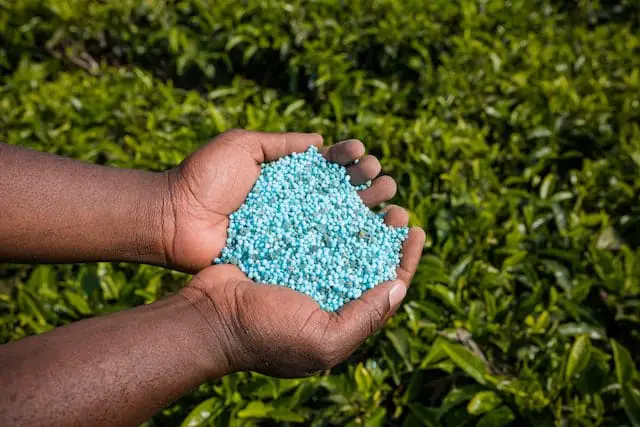
Mint plants require proper fertilization and nutrient management to grow healthy and strong. Inadequate nutrient supply can lead to stunted growth, yellowing of leaves, and ultimately, death of the plant. This section will discuss the basic nutrient requirements of mint plants and how to fertilize them properly.
1. Nitrogen
Nitrogen is a crucial nutrient for mint plants. It is responsible for the green color of leaves and helps in the production of chlorophyll, which is essential for photosynthesis.
A lack of nitrogen can lead to yellowing of leaves and stunted growth. To ensure that your mint plant gets enough nitrogen, you can use a nitrogen-rich fertilizer. A good option is a 10-10-10 fertilizer, which contains equal parts of nitrogen, phosphorus, and potassium.
2. Phosphorus
Phosphorus is another essential nutrient for mint plants. It is responsible for root development, flower formation, and fruit production. A lack of phosphorus can lead to poor root development, weak stems, and reduced flower and fruit production.
To ensure that your mint plant gets enough phosphorus, you can use a phosphorus-rich fertilizer. A good option is a 5-10-5 fertilizer, which contains more phosphorus than nitrogen and potassium.
3. Lack of Nutrients
If your mint plant is showing signs of nutrient deficiency, such as yellowing of leaves or stunted growth, it may be lacking in one or more essential nutrients. To determine which nutrient is deficient, you can conduct a soil test. Once you know which nutrient is lacking, you can use a fertilizer that contains that nutrient.
4. Fertilizer Application
To fertilize your mint plant, you can use either a granular or liquid fertilizer. Granular fertilizers are applied to the soil and then watered in. Liquid fertilizers are mixed with water and then applied to the soil. Whichever type of fertilizer you choose, be sure to follow the instructions on the package for application rates and frequency.
Pruning and Repotting Mint Plants

Pruning and repotting are essential steps in reviving a dying mint plant. Pruning helps to promote new growth and maintain the plant’s shape, while repotting ensures that the plant has enough space to grow and access to fresh nutrients.
Pruning Mint Plants
Mint plants should be pruned regularly to prevent them from becoming too leggy and to encourage new growth. Pruning also helps to prevent the plant from flowering and going to seed, which can reduce the quality and potency of the leaves.
To prune a mint plant, use sharp pruning shears to cut the stems back by about half. Cut the stems just above a set of leaves, as this will cause two new stems to grow from the ones you cut. Repeat this process every few weeks to keep the plant healthy and productive.
Repotting Mint Plants
Mint plants are known for their aggressive growth and can quickly outgrow their pots. Repotting is necessary when the plant becomes root-bound, which means the roots have filled the pot and have nowhere else to go.
To repot a mint plant, choose a pot that is at least 12 inches in diameter and has drainage holes in the bottom. Fill the pot with a high-quality potting mix that is well-draining and rich in organic matter.
Gently remove the plant from its current pot and loosen the roots. Place the plant in the new pot and fill in the gaps with potting mix. Water the plant thoroughly and place it in a sunny location.
If the mint plant has become too large and unwieldy, it may be necessary to divide it. To do this, carefully remove the plant from its pot and separate the rhizomes (underground stems) into smaller sections. Each section should have at least one stem and a healthy root system.
Repot each section into its own pot using the same method as above. Water the plants thoroughly and place them in a sunny location.
By pruning and repotting a dying mint plant, you can help it to recover and thrive. With proper care, your mint plant can provide you with fresh, flavorful leaves for years to come.
Reviving a Dying Mint Plant

Mint is a hardy herb that can grow well in most conditions. However, even the most resilient plants can fall victim to disease, pests, or environmental stressors. If you notice your mint plant is dying, don’t give up hope just yet. With a little bit of care and attention, you can revive your plant and encourage it to thrive once again.
1. Assess the Damage
The first step in reviving a dying mint plant is to assess the damage. Look for signs of wilting, yellowing leaves, and drooping stems. These symptoms can indicate a variety of issues, including overwatering, underwatering, root rot, or pest infestations.
Once you have identified the problem, you can take steps to address it and help your plant recover.
2. Transplant to a New Pot
If your mint plant is suffering from root rot or other soil-borne diseases, it may be necessary to transplant it to a new pot. Choose a pot that is slightly larger than the current one and fill it with fresh, well-draining soil.
Gently remove the plant from its old pot, being careful not to damage the roots, and replant it in the new pot. Water the plant thoroughly and place it in a bright, sunny location.
3. Provide Proper Care
Mint plants require regular watering, but overwatering can lead to root rot and other issues. Make sure the soil is moist but not waterlogged, and avoid letting the plant sit in standing water.
Mint also prefers slightly acidic soil with a pH of around 6.5 to 7.0. You can add compost or other organic matter to the soil to improve its structure and nutrient content.
4. Pest Control
Pests can also be a problem for mint plants, especially if they are grown indoors. Common pests include spider mites, aphids, and whiteflies. If you notice signs of pest infestation, such as yellowing leaves or sticky residue on the plant, take action immediately.
You can use natural pest control methods, such as neem oil or insecticidal soap, to eliminate the pests and prevent them from returning.
Additional Tips for Mint Plant Care
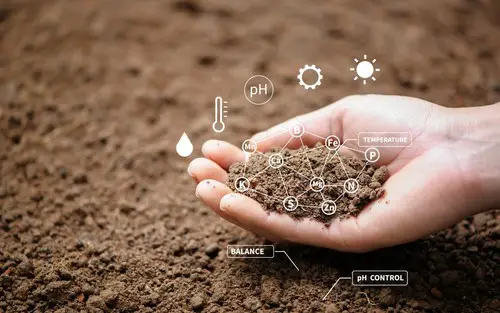
Mint plants are relatively easy to care for, but there are some extra tips that can help ensure their health and longevity. Here are a few additional tips for mint plant care:
1. Soil and pH
Mint plants prefer slightly acidic soil with a pH between 6.0 and 7.0. If the soil is too alkaline, the plant may suffer from nutrient deficiencies. Adding compost or other organic matter to the soil can help improve its acidity and nutrient content.
2. Watering
Mint plants require consistent moisture to thrive, but over-watering can lead to root rot and other problems. It’s best to water the plant deeply once or twice a week rather than giving it frequent shallow waterings. Make sure the soil is well-drained to avoid waterlogged roots.
3. Mulching
Applying a layer of mulch around the base of the mint plant can help retain moisture and regulate soil temperature. This can be especially important during hot weather or cold snaps.
4. Fertilizing
Mint plants are heavy feeders and benefit from regular fertilization. A balanced fertilizer with equal parts nitrogen, phosphorus, and potassium can help promote healthy growth. However, be careful not to over-fertilize, as this can cause burning and other problems.
5. Pruning
Regular pruning can help keep mint plants healthy and bushy. Pinching back the tips of the stems can encourage branching and prevent the plant from becoming too leggy. Harvesting the leaves regularly can also help promote new growth.
By following these additional tips for mint plant care, gardeners can help prevent problems like root rot, heat stress, and shallow root growth. With proper care, mint plants can thrive and provide fresh leaves for culinary and medicinal use.
Frequently Asked Questions
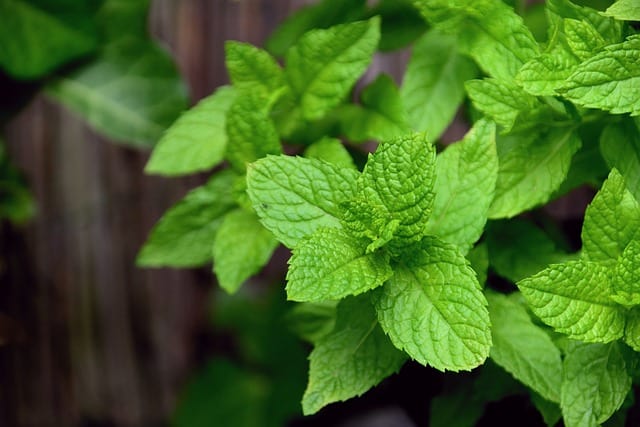
How often should I water my mint plant?
Mint plants thrive in moist soil, so it is important to keep the soil consistently moist but not waterlogged. As a general rule, water your mint plant deeply once a week, or more often during hot and dry weather.
However, the frequency of watering may vary depending on the climate, soil type, and pot size. It is best to check the soil moisture level regularly by sticking your finger about an inch deep into the soil. If it feels dry, it’s time to water.
What are some signs that my mint plant is getting too much or too little water?
Overwatering or underwatering can cause stress to your mint plant, leading to yellowing leaves, wilting, and stunted growth. Signs of overwatering include yellowing leaves, mushy stems, and a foul odor coming from the soil.
Signs of underwatering include dry, crispy leaves, and a wilted appearance. It is important to strike a balance between watering enough to keep the soil moist, but not so much that the roots are sitting in water.
What kind of soil does mint need to thrive?
Mint plants prefer rich, slightly acidic soil with good drainage. A pH range of 6.5 to 7.0 is ideal. You can achieve this by mixing equal parts of potting soil, compost, and perlite or sand. Avoid using heavy clay soil or soil that is too compacted, as it can lead to poor drainage and root rot.
Can I save a mint plant that is wilting or turning brown?
Yes, you can save a mint plant that is wilting or turning brown. The first step is to identify the cause of the problem. It could be due to overwatering, underwatering, pests, disease, or other environmental factors.
Once you have identified the cause, take appropriate action to address it. For example, if the plant is overwatered, reduce watering and improve drainage. If it is underwatered, increase watering frequency. If pests or disease are the issue, use appropriate treatments.
How much sunlight does a mint plant need to survive?
Mint plants prefer partial shade to full sun, but they can also tolerate shade. Ideally, they should receive at least 4-6 hours of direct sunlight per day.
However, in hot and dry climates, too much direct sunlight can cause the plant to wilt. In such cases, it is best to provide some shade during the hottest part of the day.
What are some common pests or diseases that affect mint plants and how can I prevent or treat them?
Mint plants are susceptible to several pests and diseases, including spider mites, aphids, whiteflies, rust, and powdery mildew. To prevent these problems, it is important to keep the plant healthy by providing adequate water, sunlight, and nutrients.
You can also use organic pest control methods such as neem oil or insecticidal soap to control pests. For diseases, remove infected leaves and improve air circulation around the plant.

Hey, I’m Lisa and I’ve been an avid gardener for over 30 years. I love writing, talking and living in the garden! Feel free to connect with me on my socials below

